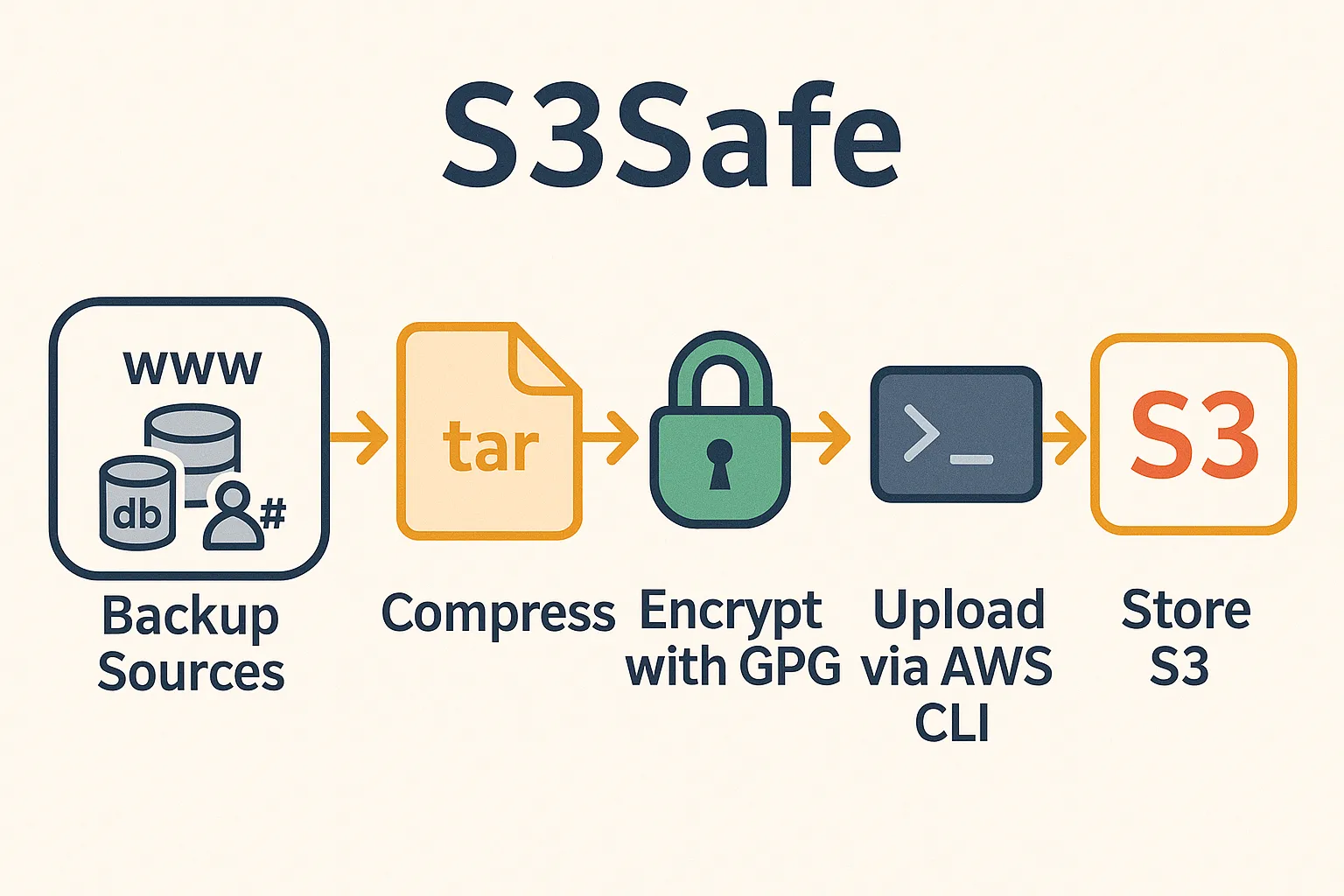S3Safe is a robust Bash script for backing up websites, databases, and database users to any S3-compatible storage (e.g., AWS S3, Cloudflare R2, Google Cloud Storage, Infomaniak Swiss Backup) using AWS CLI. It compresses, encrypts backups with GPG, and uploads them securely. Features include retry logic for reliability, notifications for failures, and flexible configuration for components (WWW, DB, DB users). Logs provide detailed tracking, with optional debugging modes.
Features
- Backs up websites, MariaDB/MySQL databases, and database users.
- Supports any S3-compatible storage via AWS CLI.
- Compresses and encrypts backups with GPG for security.
- Configurable backup components (enable/disable WWW, DB, DB users).
- Retry logic for compression, encryption and S3 uploads for websites, databases and database users, and database dumps.
- Supports multiple notification methods for failures (can be disabled for custom monitoring, e.g., Zabbix):
- ntfy
- Telegram Bot
- Webhook
- Customizable backup, snapshot, and log directories.
- Debugging modes for detailed logging and S3 upload skipping.
- Logs all operations for monitoring and troubleshooting.
S3 Storage Structure
s3://<bucket>/
├── www/<site_name>/<timestamp>/www-<site_name>.tar.gz.gpg
├── db/<database_name>/<timestamp>/db-<database_name>.tar.gz.gpg
└── db-users/global/<timestamp>/db-users.tar.gz.gpgRequirements
Before running the script, ensure:
- Linux environment with Bash.
- MariaDB or MySQL (script supports both).
- AWS CLI installed and configured.
- GPG for encryption.
curlfor Telegram notifications (if enabled).rsyncandtarfor file operations.
Installation
1. Install Dependencies:
sudo apt update
sudo apt install mariadb-client awscli gnupg curl rsync tar2. Configure AWS CLI:
Install AWS CLI if not already installed:
curl "https://awscli.amazonaws.com/awscli-exe-linux-x86_64.zip" -o "awscliv2.zip"
unzip awscliv2.zip
sudo ./aws/installConfigure credentials for your S3-compatible storage:
aws configureSet your access key, secret key, region (if applicable), and output format.
3. Set Up GPG Encryption:
- Generate or obtain a GPG key pair (public/private).
- Import the public key on the backup server:
gpg --import public_key.asc- Security Note: GPG encryption ensures backups are secure. Store the private key safely and never expose it. Verify the public key is correctly imported to avoid encryption failures.
4. Configure MariaDB/MySQL Credentials:
- Create a
~/.my.cnffile for passwordless access:
nano ~/.my.cnf- Add:
[client]
user=<your_db_user>
password=<your_db_password>- Secure the file:
chmod 600 ~/.my.cnfConfiguration
1. Copy Configuration Files:
cp .env.example .env
cp s3safe.conf.example s3safe.conf- Secure
.env
chmod 600 .env 2. Edit .env:
Update the following:
S3_BUCKET: Your S3 bucket name.S3_ENDPOINT: Your S3-compatible endpoint URL.GPG_RECIPIENT: GPG key ID or email for encryption.NTFY_TOPIC: ntfy topic (optional).TELEGRAM_BOT_TOKEN: Telegram bot token (optional).TELEGRAM_CHAT_ID: Telegram chat ID (optional).WEBHOOK_URL: Webhook URL (optional).- Note: Notifications are enabled by default in
s3safe.conf(disable if not using), and all notification methods set in .env will be used.
3. Edit s3safe.conf:
Server Name:
- Set
SERVERto your server’s name (e.g., MyServer).
Components:
- Enable/disable components to back up:
COMPONENT_WWW=on(backs up websites).COMPONENT_DB=on(backs up databases).COMPONENT_DB_USERS=on(backs up database users).
Notifications:
- Set
NOTIFICATIONS=offto disable notifications and monitor logs manually (e.g., via Zabbix), or leave it on to receive notifications.
WWW Root:
- Set
WWWROOTto your web root (e.g.,/var/www). Defaults to/var/wwwif unset. The script backs up all directories in this path.
Directories:
BACKUP_DIR: Temporary storage (default:$HOME/backup).SNAP_DIR: Snapshot directory (default:$BACKUP_DIR/snap/www).LOG_DIR: Log storage (default:$BACKUP_DIR/logs).
Debugging:
DEBUG=on: Enables detailed logging to console and log file.DEBUG_VERBOSE=on: Logs exceptions and file lists (requiresDEBUG=on).DEBUG_SKIP_S3=on: Skips S3 uploads for testing.
4. Test the Script
Run manually to verify configuration:
chmod +x s3safe.sh
./s3safe.shCheck logs in LOG_DIR for errors before scheduling.
Example Output
With DEBUG=off, backing up domain.com, database domain_com and database users:
Backup of WWW, DB and DB Users started at: 20250628_234510
Backing up website: domain.com
Compressed website: domain.com
Website uploaded: domain.com
Website backed up: domain.com
Backing up database: domain_com
Compressed database: domain_com
Uploaded database: domain_com
Database backed up: domain_com
Backing up database users
Compressed database users
Database users uploaded
Database users backed up
Backup completed at: 20250628_235010Scheduling
Schedule daily backups at 01:00:
crontab -eAdd:
0 01 * * * /path/to/s3safe.shAdditional Notes
- Backup Retention: Configure lifecycle rules on your S3-compatible storage to manage backup retention (e.g., retain last 14 days).
- Log Management: Logs are stored in
LOG_DIR. Set uplogrotateto manage log files. - Error Handling: The script retries failed operations (compression, encryption and S3 uploads for websites, databases and database users, and database dumps) up to 2 times (3 times total). Enable push notifications for failure alerts or monitor logs through custom software or manually.
- Security: Ensure
~/.my.cnfand.envpermissions are restricted (chmod 600). Verify GPG keys are correctly set up to prevent encryption errors.



